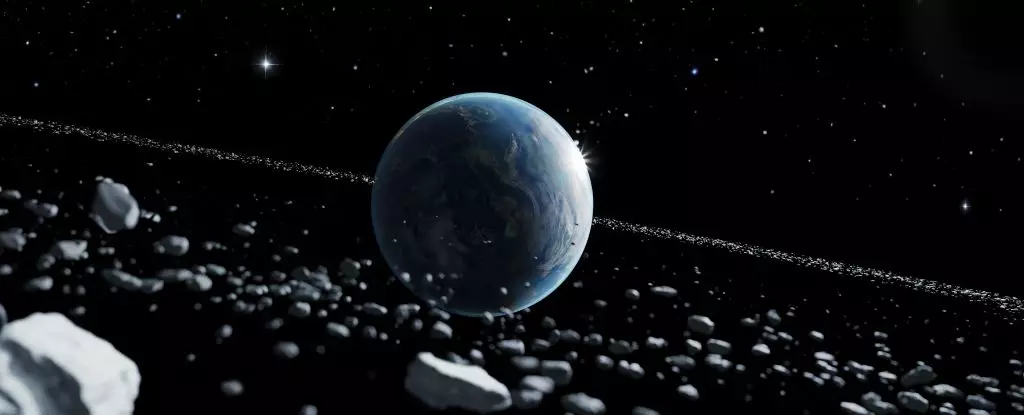Understanding Earth’s history often feels like piecing together a jigsaw puzzle with some parts missing. One intriguing theory suggests that our planet may have once possessed its own planetary ring, akin to those adorning the gas giants in our solar system. This hypothesis emerges from the analysis of a significant geological anomaly known as the Ordovician impact spike, a period marked by an unprecedented increase in meteorite activity. This speculative narrative, led by planetary scientist Andy Tomkins from Monash University, has opened up a captivating exploration into the dynamics of planetary formation and the implications for Earth’s evolution.
The Ordovician period, which lasted from about 485 million to approximately 443 million years ago, has long fascinated geologists due to its rich fossil records and dramatic geological events. Within this timeframe, scientists have identified an intriguing spike in meteorite impacts over a relatively brief span of around 40 million years. This spike is characterized by numerous craters that suggest a concentrated bombardment, predominantly located near the equator. As Tomkins and his team analyzed this impact phenomenon, they identified a pattern that indicated a plethora of meteorites raining down on Earth, raising a tantalizing question about the origins of such unexpected celestial activity.
One critical insight from their research is the clustering of 21 significant craters, which are all located within 30 degrees of the equator. The correlation of these craters is perplexing, particularly given that, during the Ordovician, the continents were assembled into the supercontinent Gondwana, which has since drifted apart. This clustering suggests a coherent source for the meteoric material, potentially linking it to a hypothetical ring that orbited Earth.
Speculative Origins: The Hypothetical Ring
According to the proposed theory, an asteroid may have come too close to Earth, entering a delicate gravitational boundary known as the Roche limit. When an object breaches this limit, tidal forces can tear it apart, resulting in debris that could form a temporary ring system around the planet. This ejected material would then spiral down towards Earth over millions of years, leading to the spike in impacts that scientists observe in the geological record.
Tomkins posits that at a distance of around 15,800 kilometers, such a ring could exist in a stable orbit, slowly decaying over time. The phenomenon can be likened to the temporary rings of Saturn or the chaotic remnants left in Jupiter’s vicinity after comet Shoemaker-Levy 9 disintegrated in 1994. The discussions surrounding the possible existence of such rings on Earth allow us to consider how astronomical events can impact terrestrial conditions and consequently, the trajectory of life on our planet.
The Broader Implications: Climate and Evolution
The implications of this theory extend far beyond understanding meteorite impacts; they venture into the realm of climate dynamics and the evolutionary pressures faced by organisms during the Ordovician period. Towards the end of this period, Earth entered a harsh ice age, which was unprecedented in the last 500 million years. It stands to reason that the presence of a mysterious ring could have contributed to this climatic shift by altering sunlight distribution, possibly casting shadows on the planet’s surface.
If this ring indeed played a role in altering climatic conditions, it could suggest a vital interplay between celestial mechanics and biological evolution. The Great Ordovician Biodiversification Event, characterized by rapid evolution and diversification of species, could also be linked to these significant climatic changes. An indirect tie between the ring and the evolutionary pressures faced by early life forms presents a riveting opportunity to explore how extraterrestrial events can redefine biological landscapes.
While the notion of an Earth ring may seem far-fetched, it is essential to approach it with scientific rigor. Tomkins underscored the necessity for future research, including numerical modeling that would simulate the breakup of the prospective asteroid and the formation and evolution of the hypothetical ring. Such studies could also investigate whether the ring would produce notable shadows large enough to affect Earth’s climate significantly.
Furthermore, coupling these insights with climate science could enhance our understanding of historical and potential future climatic scenarios. The speculative thought of manipulating extraterrestrial bodies for climate intervention, as Tomkins suggested, could even ignite discussions about terraforming habitable worlds, although such possibilities remain largely theoretical at this stage.
The existence of an ancient ring around Earth remains a tantalizing mystery. As we deepen our investigation into the cosmos, the hypothetical ring serves not only as an exciting narrative but also as a gateway to understanding the complex interrelation between astronomical phenomena, Earth’s climatic history, and biological evolution. Though we may not unlock all the answers immediately, the journey to explore our planet’s past is likely to yield invaluable insights into our future.


Leave a Reply